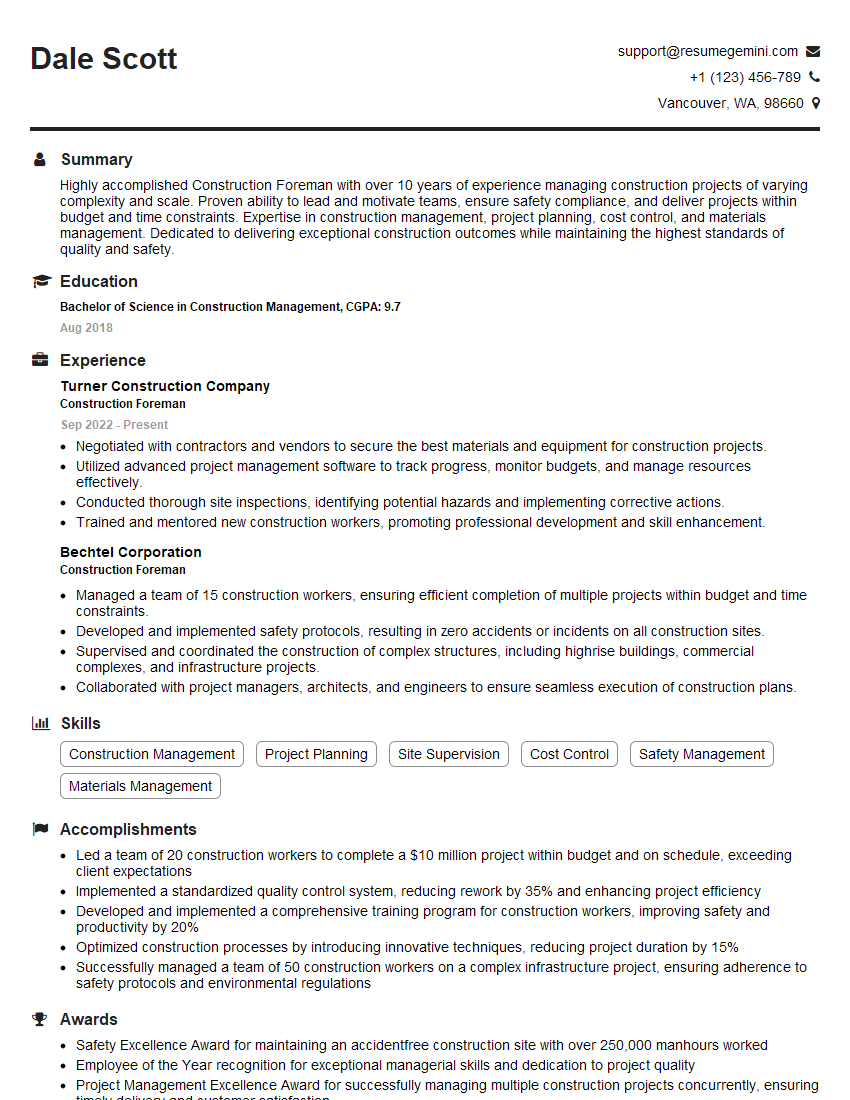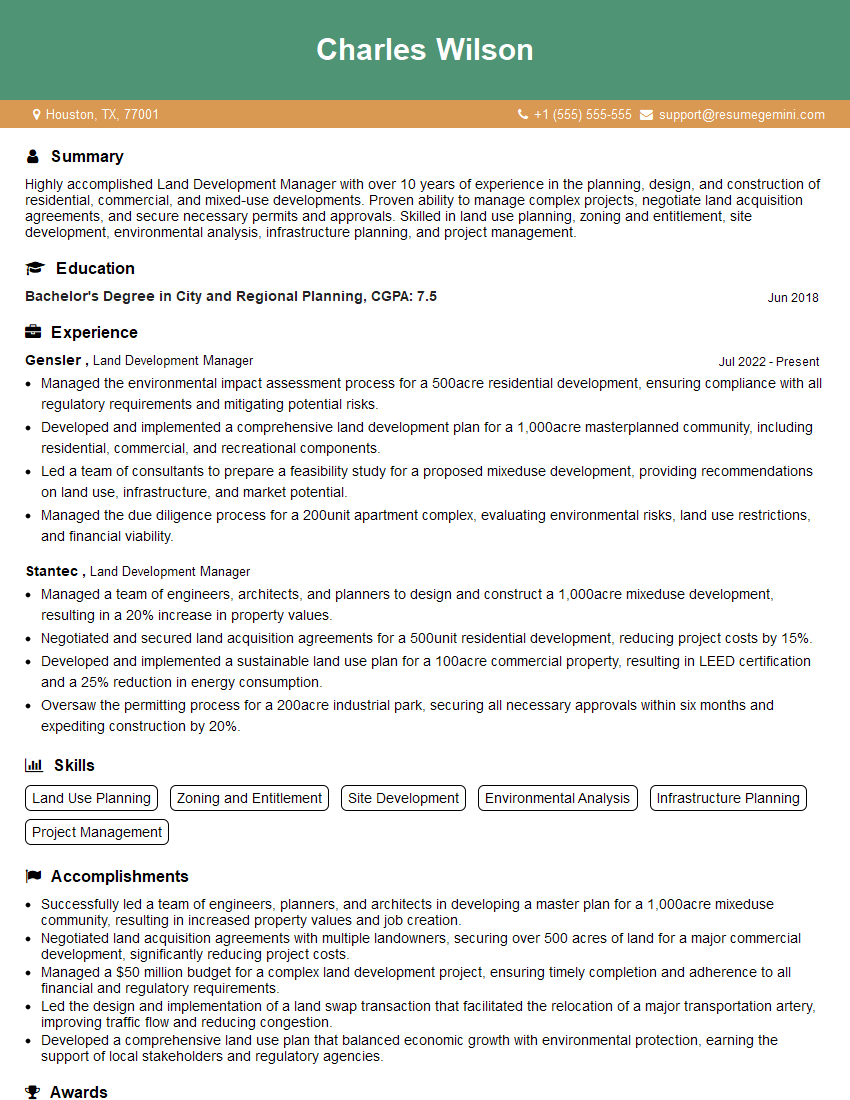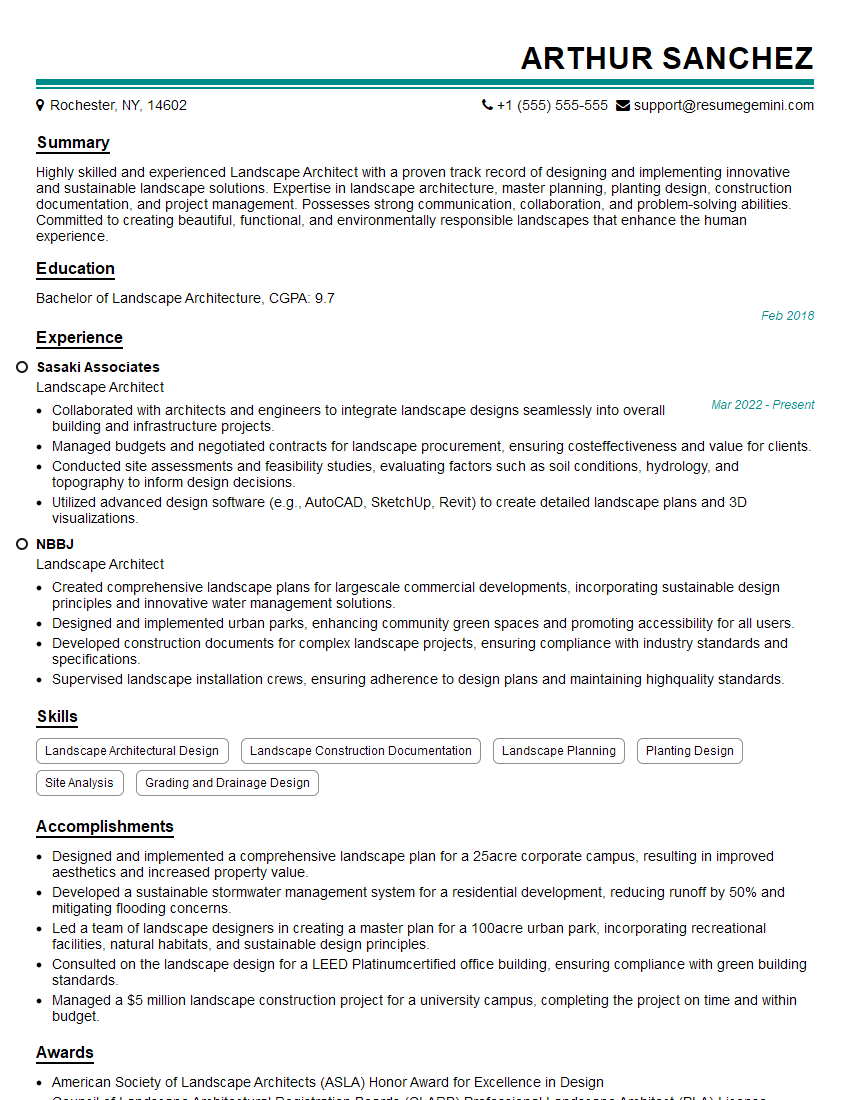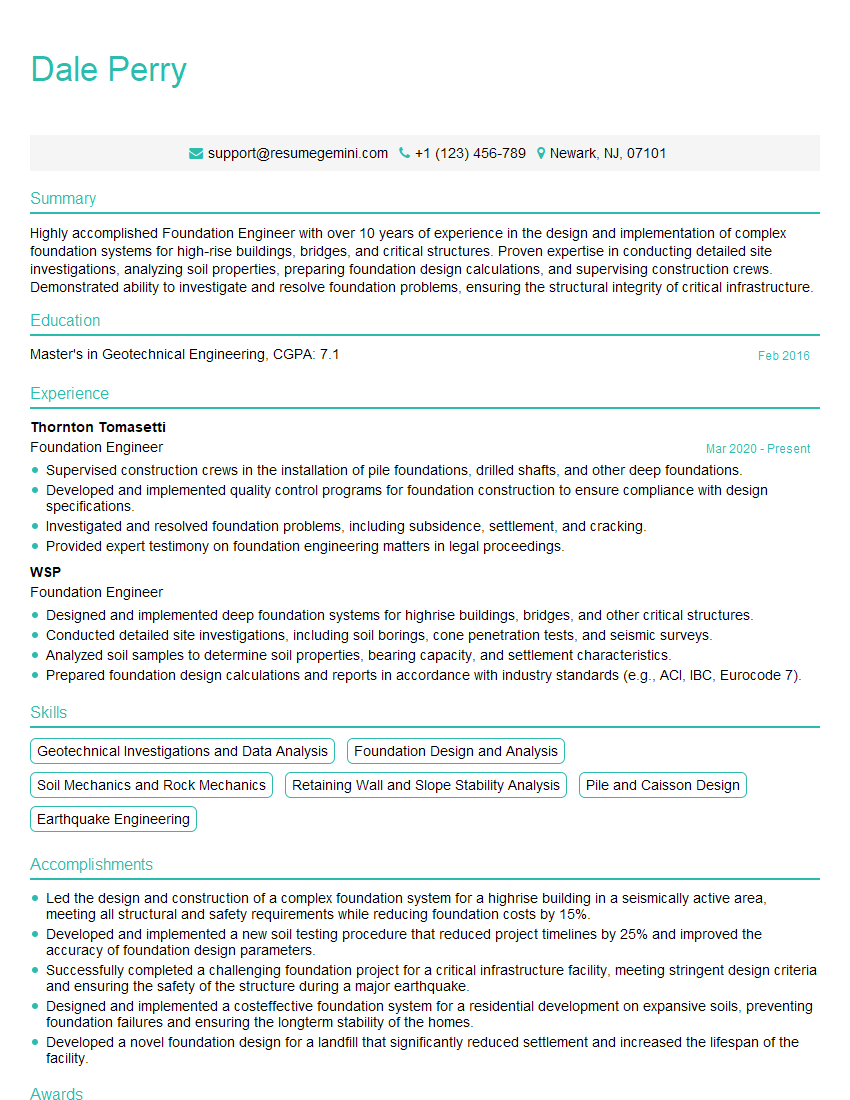The right preparation can turn an interview into an opportunity to showcase your expertise. This guide to Soil and Ground Preparation Techniques interview questions is your ultimate resource, providing key insights and tips to help you ace your responses and stand out as a top candidate.
Questions Asked in Soil and Ground Preparation Techniques Interview
Q 1. Explain the different types of soil and their engineering properties.
Soil classification is crucial in geotechnical engineering. We categorize soils based on particle size, grain shape, and other physical properties. This impacts their engineering behavior, determining suitability for construction.
- Gravel: Large particles (over 2mm). Well-graded gravels have a good range of particle sizes and drain well, making them suitable for road bases and foundations. Poorly graded gravels can be weaker.
- Sand: Particles between 0.075mm and 2mm. Like gravel, its drainage is excellent. However, its bearing capacity is lower than gravel, and it’s susceptible to liquefaction under seismic conditions.
- Silt: Particles between 0.002mm and 0.075mm. Silt is finer than sand and has low permeability, making it difficult to drain. It can be prone to settlement and is often considered problematic in construction.
- Clay: Particles smaller than 0.002mm. Clay’s behavior is significantly influenced by its mineralogy and water content. It can exhibit high plasticity (moldability) when wet and high strength when dry, but also significant shrinkage and swelling properties, making it challenging to work with.
- Organic Soil: Contains significant amounts of decaying organic matter. These soils are highly compressible and have low shear strength, often requiring extensive treatment or avoidance in construction projects.
Think of it like building a house: you wouldn’t use clay as the foundation if you want a stable structure. Understanding soil types allows engineers to select appropriate foundation designs and ground improvement techniques to mitigate risks.
Q 2. Describe various soil stabilization techniques.
Soil stabilization improves soil engineering properties to make it suitable for construction. Various methods exist, each suited for specific soil types and project requirements.
- Mechanical Stabilization: This involves compacting the soil using rollers or vibratory equipment to increase its density and strength. This is common for granular soils.
- Chemical Stabilization: Chemicals like lime, cement, or fly ash are mixed with the soil to improve its strength, reduce plasticity, and enhance drainage. Lime is commonly used for clayey soils, improving their bearing capacity.
- Thermal Stabilization: Heating the soil alters its properties. This is less common but can be effective for specific applications.
- Biostabilization: Using microorganisms to bind soil particles together. This is an eco-friendly method, particularly suitable for softer soils.
- Geosynthetics: Materials like geotextiles, geogrids, and geomembranes can reinforce and stabilize soils. Geogrids are often used to improve the strength of weak soils.
For example, if we encounter expansive clay soil (soil that swells when wet), we might use lime stabilization to reduce its swelling potential and enhance its strength, thereby preventing foundation damage.
Q 3. How do you determine the bearing capacity of soil?
Determining bearing capacity – the maximum pressure soil can withstand without failure – is crucial for safe foundation design. It’s determined through a combination of methods:
- In-situ Tests: These tests are conducted directly on the soil. Examples include the Standard Penetration Test (SPT), Cone Penetration Test (CPT), and Plate Load Test. The SPT involves driving a split-barrel sampler into the ground and measuring the resistance.
- Laboratory Tests: Soil samples are tested in a lab to determine shear strength parameters, which are then used in calculations to estimate bearing capacity. Common tests include triaxial and direct shear tests.
- Empirical Methods: Simplified methods based on correlations between soil properties and bearing capacity are used. These are less accurate than in-situ and laboratory tests but are useful for preliminary estimations.
The choice of method depends on factors like project scale, budget, and soil complexity. A geotechnical engineer uses these data to design appropriate foundations, ensuring the structure can safely support the anticipated loads.
Q 4. What are the common methods for ground improvement?
Ground improvement aims to enhance the engineering characteristics of soil to support structures safely and economically.
- Compaction: Increases soil density and strength, reducing settlement. This is a common method for granular soils.
- Deep Mixing: Mixing columns of stabilizing agents (e.g., cement or lime) into the ground to create improved soil zones. This is effective for soft clays.
- Vibro-compaction: Uses vibratory equipment to densify loose, granular soils. It’s useful for improving the bearing capacity of sandy soils.
- Stone Columns: Installing columns of granular material into soft soils to improve their strength and reduce settlement.
- Soil Replacement: Excavating unsuitable soil and replacing it with better material. This is a more expensive method but effective for highly problematic soils.
Imagine building on a very soft clay soil. Deep mixing could be used to create stronger zones within the clay, providing a stable base for the structure, reducing the risk of excessive settlement.
Q 5. Explain the process of soil compaction and its importance.
Soil compaction is a crucial process in ground preparation. It involves increasing the density of soil by reducing air voids through mechanical means. This leads to increased shear strength, reduced compressibility, and improved stability.
The process typically involves using heavy machinery like rollers, compactors, or vibratory plates. The choice of equipment depends on soil type and project requirements.
Importance of Compaction:
- Increased Bearing Capacity: Reduces the risk of settlement and ensures structural stability.
- Reduced Permeability: Minimizes water infiltration, preventing erosion and instability.
- Improved Drainage: In some cases, compaction can improve drainage, especially in granular soils.
- Enhanced Durability: Makes the soil more resistant to degradation and ensures the longevity of the constructed elements.
For example, a road base must be properly compacted to withstand the load of traffic. Improper compaction would lead to uneven settlement, causing damage to the road surface.
Q 6. What are the factors affecting soil erosion and how can it be prevented?
Soil erosion is the detachment and movement of soil particles by natural forces (wind, water). This leads to land degradation, loss of fertility, and environmental problems.
Factors Affecting Soil Erosion:
- Rainfall Intensity: High-intensity rainfall detaches soil particles more effectively.
- Slope Gradient: Steeper slopes facilitate faster runoff, increasing erosion.
- Soil Properties: Loose, sandy soils are more susceptible to erosion than cohesive, clayey soils.
- Vegetation Cover: Lack of vegetation exposes soil to erosive forces.
- Wind Speed: Strong winds can cause significant soil erosion in arid and semi-arid regions.
Erosion Prevention Techniques:
- Contour Farming: Planting along the contours of slopes reduces the speed of runoff.
- Terracing: Creating level platforms on slopes to reduce runoff velocity.
- Revegetation: Planting vegetation to protect soil from wind and water erosion.
- Mulching: Applying organic matter to the soil surface to improve its resistance to erosion.
- Engineering Structures: Using structures like check dams and retaining walls to control water flow.
For instance, along riverbanks, planting vegetation like willows helps stabilize the soil and prevent riverbank erosion.
Q 7. Describe different types of excavation methods.
Excavation methods are chosen based on the soil type, depth, and project requirements.
- Open Cut Excavation: The most common method, involving digging a trench or pit. Suitable for shallow excavations in stable soil.
- Trenching: Excavating narrow, deep trenches, usually for utility lines. Requires shoring or other support systems if the trench is deep or in unstable soil.
- Mass Excavation: Removing large volumes of soil, typically for large-scale projects like building foundations or earthworks. Often involves the use of heavy machinery like excavators and bulldozers.
- Underwater Excavation: Excavating below the water table. Specialized techniques and equipment are required, such as dredging or divers.
- Controlled Blasting: Used for rock excavation or when breaking up hard soil layers. Safety measures are critical in blasting operations.
The choice of method directly affects project cost and schedule. For instance, if you’re excavating for a building’s foundation on a sloping site, you might need to use a combination of mass excavation and terracing to ensure stability.
Q 8. How do you manage groundwater during excavation?
Managing groundwater during excavation is crucial for safety and project success. High groundwater levels can lead to unstable excavation walls, delays, and even collapses. The approach depends heavily on the site’s specific hydrogeology and the depth of the excavation.
Methods include:
- Dewatering: This involves lowering the water table using wells, sumps, and pumps. This is effective for large-scale projects but can be expensive and environmentally impactful. Think of it like draining a bathtub before you can clean it.
- Well points: These are small-diameter wells driven into the ground, creating a localized zone of drawdown. They’re ideal for smaller projects and less disruptive than large-scale dewatering.
- Sheet piling or slurry walls: These create a waterproof barrier around the excavation, preventing groundwater inflow. They’re more suitable for deep excavations in challenging conditions. Imagine these as giant, waterproof curtains surrounding your excavation.
- Groundwater monitoring: Continuous monitoring is essential to assess the effectiveness of chosen methods and make adjustments as needed. This is like checking the water level in your bathtub while you’re draining it.
Choosing the right method: The choice depends on factors like the groundwater level, soil type, excavation depth, proximity to sensitive areas, and project budget. A thorough hydrogeological assessment is essential before selecting a dewatering technique.
Q 9. What safety precautions are essential during ground preparation?
Safety is paramount during ground preparation. Numerous hazards exist, requiring comprehensive safety measures.
- Proper Site Inspection: A thorough inspection should identify potential hazards like unstable ground, underground utilities, and presence of hazardous materials.
- Excavation Safety: This includes using appropriate shoring, sloping, or benching techniques to prevent wall collapse. Protective systems, like trench boxes, are crucial for worker safety in trenches.
- Personal Protective Equipment (PPE): Workers must wear appropriate PPE, including hard hats, safety glasses, high-visibility clothing, and safety boots. This is non-negotiable.
- Traffic Control: Proper signage and barriers are needed to prevent accidents involving vehicles and pedestrians near excavation sites. Clear communication and designated routes are vital.
- Hazard Communication: Workers should be thoroughly informed about all potential hazards present on the site, including the presence of hazardous materials (asbestos, for example). Training is essential.
- Emergency Procedures: Emergency response plans, including evacuation routes and contact information for emergency services, should be established and communicated effectively to all personnel.
Failing to implement these measures can lead to serious accidents, injuries, and even fatalities. A proactive and robust safety plan is an investment, not an expense.
Q 10. Explain the significance of soil testing in construction.
Soil testing is fundamental to successful construction. It provides critical information about the soil’s engineering properties, guiding design decisions and preventing potential problems down the line. Imagine building a house without knowing if the ground beneath it is solid – a recipe for disaster!
Types of soil testing:
- Classification tests: Determine the soil type (clay, sand, gravel, etc.), which influences its behavior and load-bearing capacity.
- Strength tests: Measure the soil’s shear strength and compressive strength, essential for designing foundations.
- Consolidation tests: Assess the soil’s compressibility, crucial for predicting settlement.
- Permeability tests: Determine how easily water flows through the soil, relevant for drainage design and groundwater management.
Consequences of inadequate testing: Insufficient or poorly conducted soil testing can lead to foundation failures, structural damage, increased construction costs due to unforeseen problems, and even safety risks. A thorough soil investigation is an essential cost-effective investment in a project’s long-term success.
Q 11. Describe different types of retaining walls and their applications.
Retaining walls are structures designed to hold back soil, preventing slope failure and providing support for different ground levels. They come in various types, each with its own applications.
- Gravity walls: These rely on their own weight for stability. They are suitable for low heights and stable soils. Think of a simple, massive stone wall.
- Cantilever walls: These are reinforced concrete walls with a stem and base slab. The stem resists soil pressure while the base slab provides stability. They’re common in residential and commercial projects.
- Counterfort walls: Similar to cantilever walls, but with counterforts (buttresses) extending from the stem to the base, improving stability and allowing for taller walls. Think of a cantilever wall with added support.
- Anchored walls: These use anchors (tendons) to tie the wall back into stable soil or rock, allowing for taller and thinner walls. It’s like securing a picture frame with wires to prevent it from falling.
- Gabion walls: These use wire baskets filled with rocks, providing a cost-effective and environmentally friendly solution, particularly in areas with aesthetic considerations.
The choice of retaining wall depends on factors such as height, soil conditions, aesthetics, and budget. A geotechnical engineer will assess the site conditions and recommend the most appropriate type.
Q 12. How do you select appropriate foundation types based on soil conditions?
Selecting the appropriate foundation type is critical for structural stability and longevity. Soil conditions are the primary factor influencing this decision.
Examples:
- Shallow foundations (e.g., spread footings, strip footings, raft foundations): These are suitable for stable soils with high bearing capacity and are used for low-rise buildings. Imagine spreading the load of a table across its four legs.
- Deep foundations (e.g., piles, caissons): These are employed when shallow foundations are unsuitable due to weak or compressible soils or when supporting heavy loads. Think of these as extending deep roots to anchor the structure.
Considerations:
- Soil Bearing Capacity: The ability of the soil to support the weight of the structure.
- Soil Compressibility: How much the soil will settle under load.
- Groundwater Level: The presence of groundwater can affect soil strength and foundation design.
- Seismic Activity: Foundations need to be designed to withstand seismic forces in earthquake-prone areas.
A thorough geotechnical investigation is required to determine the appropriate foundation type. Ignoring soil conditions can lead to significant structural problems and potentially catastrophic failure.
Q 13. Explain the concept of settlement and its impact on structures.
Settlement is the gradual compaction and consolidation of soil beneath a structure, resulting in vertical movement. All structures settle to some extent, but excessive or uneven settlement can cause significant damage.
Types of Settlement:
- Immediate settlement: Occurs immediately after the load is applied, primarily due to elastic deformation of the soil.
- Consolidation settlement: A gradual process involving the expulsion of water from the soil pores, leading to compaction. This is particularly relevant for clay soils.
- Secondary settlement: Further settlement that occurs after consolidation is complete, caused by long-term creep or changes in soil structure.
Impact on Structures:
- Cracks in walls and floors: Uneven settlement can cause cracking in structural elements.
- Door and window misalignment: Differential settlement can lead to problems with openings.
- Foundation damage: Severe settlement can damage the foundation itself.
Careful site investigation and appropriate foundation design can minimize settlement, ensuring the long-term stability and integrity of the structure. Predicting and managing settlement is key to structural integrity.
Q 14. How do you deal with expansive soils?
Expansive soils, primarily clays, change volume significantly in response to changes in moisture content. This volume change can cause significant damage to structures, lifting foundations and causing cracking. Think of them as soils that ‘breathe’ with changes in moisture.
Dealing with Expansive Soils:
- Soil Stabilization: Improving the soil’s strength and reducing its expansiveness through methods such as lime stabilization or cement modification. This strengthens the soil’s structure.
- Moisture Control: Managing the moisture content of the soil to minimize volume changes. This might involve drainage systems or barriers.
- Deep Foundations: Using deep foundations, such as piles, to transfer loads below the expansive layer. This bypasses the problematic soil.
- Shallow Foundations with Special Design: Using shallow foundations with features to accommodate movement, like flexible design or incorporating expansion joints.
- Geotextiles: Using geotextiles to create a barrier that prevents moisture from reaching the expansive soil.
The approach to dealing with expansive soils depends on the degree of expansion, the project requirements, and the available budget. Proper assessment and design are critical for preventing costly damage later on.
Q 15. What are the environmental considerations during ground preparation?
Environmental considerations during ground preparation are paramount. We must minimize our impact on surrounding ecosystems and comply with relevant regulations. This involves several key aspects:
- Soil Erosion and Sediment Control: Proper planning prevents soil erosion from wind and rain, protecting waterways from sedimentation. Techniques include using silt fences, straw bales, and vegetation. For example, on a steep slope, we might employ contour plowing and terracing to reduce erosion.
- Water Management: Managing stormwater runoff is crucial. We implement measures like swales, detention basins, and infiltration systems to prevent flooding and contamination of groundwater. Think of it like building a miniature drainage system for the construction site.
- Protection of Habitats and Endangered Species: Pre-construction surveys identify sensitive habitats and species. We then adjust our plans to avoid damage or disruption, potentially relocating species or implementing mitigation strategies.
- Air Quality Management: Dust control is essential, particularly during excavation and demolition. Techniques include watering down the soil, using dust suppressants, and employing specialized equipment.
- Waste Management: Proper disposal of excavated material is critical. We separate hazardous materials like asbestos and ensure that the remaining soil is disposed of responsibly, potentially recycling it for other uses.
- Noise Pollution: Construction noise can disrupt surrounding communities. Mitigation strategies include using quieter equipment and adhering to noise ordinances.
Ignoring these considerations can lead to fines, project delays, and reputational damage. A holistic approach to environmental protection is not just ethically sound, but also economically prudent.
Career Expert Tips:
- Ace those interviews! Prepare effectively by reviewing the Top 50 Most Common Interview Questions on ResumeGemini.
- Navigate your job search with confidence! Explore a wide range of Career Tips on ResumeGemini. Learn about common challenges and recommendations to overcome them.
- Craft the perfect resume! Master the Art of Resume Writing with ResumeGemini’s guide. Showcase your unique qualifications and achievements effectively.
- Don’t miss out on holiday savings! Build your dream resume with ResumeGemini’s ATS optimized templates.
Q 16. Describe the role of geotextiles in ground improvement.
Geotextiles are permeable fabrics used to improve ground conditions. They act as a filter, separator, or reinforcement, enhancing stability and drainage. Imagine them as a sophisticated, engineered fabric that interacts with the soil.
- Separation: They prevent mixing of different soil layers, like separating fine sand from coarse gravel. This prevents the fine soil from migrating into the drainage layer, clogging it up.
- Filtration: They allow water to pass through while retaining soil particles, preventing clogging of drainage systems. Think of a high-quality coffee filter that lets the water through but keeps the grounds contained.
- Reinforcement: They enhance the tensile strength of the soil, increasing its load-bearing capacity. This is especially useful in areas with weak or unstable soils.
- Protection: They protect underlying layers from damage or erosion during construction activities.
For example, geotextiles are commonly used under pavements to prevent settlement and improve drainage, or in retaining walls to separate the soil from the structural elements, preventing soil migration and improving stability. The choice of geotextile depends heavily on the specific project requirements and soil properties.
Q 17. How do you ensure proper drainage during ground preparation?
Proper drainage is crucial for preventing soil instability and ensuring the longevity of structures. This involves a combination of techniques:
- Grading: Sloping the ground away from structures directs surface water runoff. Think of it like creating a gentle incline to guide water away from your house.
- Drainage ditches and swales: These channels collect and divert surface water away from critical areas.
- Underdrains: These perforated pipes, often wrapped in geotextile, are buried beneath the ground to collect and carry subsurface water. They’re like underground veins moving water away from the structure.
- French drains: These are trenches filled with gravel and a perforated pipe to collect and transport subsurface water.
- Stormwater management systems: These systems control and manage runoff to prevent flooding and erosion.
The specific drainage strategy will depend on the site’s topography, soil type, and the intended use of the area. A poorly designed drainage system can lead to waterlogging, foundation problems, and costly repairs.
Q 18. What are the limitations of various ground improvement techniques?
Ground improvement techniques, while effective, have limitations. The suitability of a technique depends on factors such as soil type, project requirements, and cost.
- Compaction: Effective for granular soils but less effective for cohesive soils. Over-compaction can damage soil structure.
- Vibroflotation: Suitable for loose, saturated sands but not effective for stiff clays or rocky soils. It’s also noisy and can cause vibrations that affect nearby structures.
- Deep Soil Mixing: Effective for stabilizing soft soils but can be expensive and time-consuming. The depth of treatment is limited by the equipment used.
- Stone Columns: Suitable for soft, compressible soils but may be less effective in highly saturated or sensitive soils. The spacing and size of columns must be carefully designed.
- Grouting: Can improve the bearing capacity of soils but requires careful control of grout parameters to ensure even distribution. It can be difficult to reach all the required areas of treatment.
Careful site investigation and engineering analysis are crucial for selecting the appropriate ground improvement technique and mitigating potential limitations.
Q 19. Explain the importance of proper site investigation.
Proper site investigation is the cornerstone of successful ground preparation. It provides the necessary data for design and construction, preventing costly errors and delays. Think of it as the foundation upon which the entire project is built.
A thorough investigation involves:
- Geotechnical investigations: This includes soil borings, test pits, and in-situ testing to determine the soil type, strength, and other relevant properties. This information is crucial for selecting the appropriate foundation and ground improvement techniques.
- Topographic surveys: These surveys map the land’s elevation and features, helping determine drainage patterns and potential hazards.
- Hydrogeological investigations: This examines the groundwater conditions to assess potential risks of flooding or groundwater contamination.
- Environmental site assessments: This identifies potential environmental hazards, such as contaminated soil or the presence of protected species. This ensures environmental compliance and avoids potential legal issues.
- Utility surveys: This locates underground utilities, such as gas lines, water pipes, and electrical cables, preventing accidental damage during construction.
A well-executed site investigation avoids costly surprises and ensures a safe and efficient construction process.
Q 20. How do you interpret soil boring logs?
Soil boring logs are detailed records of soil conditions encountered during drilling. They provide vital information for geotechnical engineers. Interpreting them involves understanding the notations and symbols used. For example, a log might indicate:
- Soil type: Clay, sand, gravel, silt, etc. (often with modifiers like ‘silty clay’ or ‘dense sand’).
- Soil color: This can provide clues about the soil’s composition and drainage.
- Soil consistency: Loose, dense, stiff, very stiff, hard. For example, ‘dense sand’ describes the compactness of a sandy soil layer.
- Moisture content: Wet, moist, dry. This will impact the soil’s strength and behavior.
- Standard Penetration Test (SPT) values: These values indicate the soil’s relative density and strength.
- Groundwater level: This is a critical parameter for evaluating the potential for saturation and settlement.
By carefully examining these parameters, engineers can build a complete picture of the subsurface conditions, helping them design appropriate foundations and ground improvement strategies. Inconsistencies or unexpected findings may trigger additional investigations to refine the understanding of the site’s subsurface characteristics.
Q 21. What are the different methods for determining soil density?
Determining soil density is crucial for evaluating its strength and stability. Several methods are used:
- Nuclear density gauge (Nuclear methods): Uses radioactive sources to measure the soil’s density. This is a rapid and widely used method, but requires specialized training and licensing.
- Sand cone method: A relatively simple method where a known volume of dry sand is poured into a hole, and the volume is used to calculate the soil density. It’s suitable for various soil types, but labor-intensive and less accurate.
- Rubber balloon method: A rubber balloon is used to measure the volume of a soil sample and calculate the density. This method is relatively quick and simple, but is only suitable for non-cohesive soils.
- Water displacement method: This method involves measuring the volume of water displaced by a known weight of soil to determine the soil density. Simple and accurate, but requires careful handling of soil samples.
- In-situ methods: These methods determine the density directly in the ground, without sample extraction. Examples include the cone penetrometer test (CPT) which measures the resistance to penetration, and seismic methods that use wave propagation to estimate the density.
The choice of method depends on several factors, such as the soil type, required accuracy, access, and available resources. Each method has its strengths and limitations.
Q 22. Describe the principles of slope stability.
Slope stability refers to the ability of a soil mass to remain in its natural position without sliding or collapsing. It’s governed by the balance between the forces pushing the soil downslope (driving forces) and the forces resisting this movement (resisting forces). The driving forces are primarily gravity, acting on the weight of the soil mass. Resisting forces include the shear strength of the soil, which is its ability to resist internal deformation and failure, and any external support provided by structures or vegetation.
Several factors influence slope stability, including:
- Soil type and properties: Cohesive soils (like clay) generally have higher shear strength than non-cohesive soils (like sand). The water content of the soil significantly affects its shear strength; excess water reduces it, increasing the risk of failure.
- Slope angle: Steeper slopes have higher driving forces, making them inherently less stable.
- Groundwater conditions: High groundwater levels increase pore water pressure within the soil, reducing its effective stress and shear strength. This is a major cause of landslides.
- Vegetation: Plant roots add strength to the soil, anchoring it and reducing erosion.
- Seismic activity: Earthquakes can trigger landslides by increasing the driving forces and reducing the resisting forces.
Understanding these factors is crucial for designing safe slopes and mitigating the risk of slope failures. For instance, in highway construction, engineers carefully analyze slope stability using various methods, like the limit equilibrium method, to determine the appropriate slope angle and design retaining structures if needed. A poorly designed slope can lead to costly repairs and even loss of life.
Q 23. How do you handle contaminated soil?
Handling contaminated soil requires a multi-step approach, prioritizing human health and environmental protection. The first step is thorough investigation and characterization to identify the type and extent of contamination. This usually involves soil sampling and laboratory analysis to determine the presence of contaminants like heavy metals, petroleum hydrocarbons, or other hazardous substances.
Based on the assessment, remediation strategies are chosen. These can range from:
- Excavation and off-site disposal: Contaminated soil is removed and transported to a licensed hazardous waste facility for treatment or disposal. This is effective but can be costly and disruptive.
- On-site treatment: Techniques like bioremediation (using microorganisms to break down contaminants), chemical oxidation, or thermal desorption can treat the soil in place, minimizing the need for transportation.
- Soil capping: A layer of clean soil or other impermeable material is placed over the contaminated soil to prevent further migration of contaminants.
- Phytoremediation: Using plants to absorb or break down contaminants.
All remediation activities must adhere to relevant environmental regulations and require proper documentation and monitoring to ensure effectiveness. I’ve personally overseen several projects involving contaminated soil, from small-scale residential sites to large-scale industrial cleanups, and the success of each hinged on meticulous planning, careful execution, and rigorous regulatory compliance.
Q 24. What are the legal and regulatory requirements for ground preparation?
Legal and regulatory requirements for ground preparation vary depending on location and project specifics, but generally involve obtaining necessary permits and adhering to environmental protection standards. Key aspects include:
- Building codes and zoning regulations: These define permissible land uses, construction standards, and site preparation requirements. For instance, specific excavation depths may require engineered shoring systems to prevent collapse.
- Environmental regulations: Laws concerning the handling of contaminated soil, protection of water resources, and prevention of erosion and sedimentation need to be strictly followed. This often entails submitting environmental impact assessments and obtaining environmental permits.
- Occupational safety and health regulations: Rules for worker protection, including the use of personal protective equipment (PPE) during excavation and other ground preparation activities, are mandatory. Regular safety inspections are crucial.
- Utilities coordination: Before any excavation, contacting utility companies (gas, electricity, water, telecoms) to locate and mark underground infrastructure is critical to prevent accidents and damage.
Non-compliance can result in hefty fines, project delays, and even legal action. Staying up-to-date with all applicable regulations is paramount and requires ongoing professional development.
Q 25. Explain the use of different types of equipment in ground preparation.
Ground preparation utilizes a wide array of equipment, selected based on the soil conditions, project scale, and specific tasks. Common types include:
- Excavating equipment: Backhoes, excavators, and bulldozers are used for removing topsoil, excavating trenches, and shaping the land. Their size and capabilities vary greatly, from small mini-excavators suitable for confined spaces to massive crawler excavators for large-scale projects.
- Compaction equipment: Rollers (smooth, pneumatic, vibratory), plate compactors, and tampers are used to compact the soil to achieve the desired density and stability. The type of roller is chosen according to the soil type and required compaction level.
- Grading equipment: Motor graders and bulldozers are used to level and smooth the ground surface, preparing it for construction.
- Material handling equipment: Dump trucks, front-end loaders, and conveyors transport excavated soil and other materials.
- Specialized equipment: This can include rock breakers for demolition and removal of rock formations, drilling rigs for deep excavations, and pile drivers for foundation work.
Selecting the appropriate equipment is vital for efficient and safe ground preparation. For example, using a lightweight compactor on a dense clay soil would be inefficient, while using a heavy roller on a sandy soil could lead to excessive compaction and potential instability.
Q 26. How do you manage risks associated with ground preparation?
Managing risks associated with ground preparation is a critical aspect of any project. A proactive approach involving thorough planning, risk assessment, and implementation of control measures is essential. This includes:
- Site investigation: A detailed geotechnical investigation is crucial to understand the soil conditions, groundwater levels, and presence of any potential hazards (e.g., underground utilities, contaminated soil).
- Risk assessment: Identifying potential hazards such as ground instability, collapse, equipment failure, and worker injuries. Evaluating the likelihood and severity of each hazard helps prioritize control measures.
- Safety procedures: Implementing a robust safety plan including PPE requirements, site signage, traffic control, and regular safety inspections. Training workers on safe operating procedures for all equipment is also paramount.
- Emergency response plan: Developing a plan for handling emergencies, such as equipment malfunctions, cave-ins, or injuries, including communication protocols and evacuation procedures.
- Monitoring and documentation: Regular monitoring of the site during excavation and compaction to ensure compliance with safety standards and specifications. Maintaining thorough documentation of all activities and findings is crucial for tracking progress and addressing any issues.
A comprehensive risk management plan not only protects workers and the environment but also ensures the project’s successful and timely completion.
Q 27. Describe your experience with different soil types.
My experience encompasses a wide range of soil types, from well-drained sandy soils to highly expansive clay soils and rocky formations. Each type presents unique challenges and requires different approaches to ground preparation:
- Sandy soils: These are relatively easy to excavate but can be prone to erosion and require careful compaction to achieve stability. Proper compaction techniques are crucial to prevent settlement.
- Clay soils: These soils can be very difficult to excavate and compact, and their water content significantly impacts their behavior. Expansive clays can cause significant foundation problems, requiring special treatment during ground preparation.
- Silty soils: Silts are susceptible to liquefaction under seismic conditions and require special considerations during design and construction.
- Organic soils: These soils have a high organic matter content and often low bearing capacity, requiring specialized ground improvement techniques such as preloading or soil stabilization.
- Rocky soils: These require specialized equipment, such as rock breakers and drilling rigs, for excavation. The presence of rock can make excavation more expensive and time-consuming.
My experience allows me to effectively assess and address the challenges presented by various soil types, selecting the appropriate equipment and techniques to ensure the project meets its objectives.
Q 28. How do you ensure the quality of your work in ground preparation?
Ensuring the quality of ground preparation involves a combination of careful planning, rigorous execution, and thorough quality control measures. This includes:
- Adherence to specifications: All work must be performed according to the project specifications, including excavation depths, compaction requirements, and slope angles. Regular site inspections ensure compliance.
- Quality control testing: In-situ tests (such as density tests, penetration tests) and laboratory tests (such as sieve analysis, Atterberg limits) are conducted to verify that the soil meets the required specifications. This confirms that proper compaction has been achieved.
- Documentation: Maintaining detailed records of all activities, including soil testing results, equipment logs, and inspection reports, provides a complete audit trail for quality assurance.
- Experienced personnel: Employing skilled and experienced personnel who understand the importance of quality and safety procedures is essential. This ensures proper execution of the techniques and the use of correct equipment.
- Continuous improvement: Regularly reviewing project processes and incorporating lessons learned from past projects helps to continuously improve quality and efficiency.
By implementing these measures, we consistently deliver high-quality ground preparation that meets the project requirements and exceeds client expectations. Quality is not just a goal; it’s a fundamental principle built into every step of our process.
Key Topics to Learn for Soil and Ground Preparation Techniques Interview
- Soil Classification and Properties: Understanding different soil types (clay, silt, sand, gravel), their physical and chemical characteristics, and how these impact preparation techniques.
- Site Investigation and Analysis: Methods for assessing site conditions, including soil testing, surveying, and geological reports; interpreting data to inform preparation strategies.
- Earthmoving Equipment and Techniques: Familiarity with various excavation equipment (excavators, bulldozers, graders), their applications, and safe operating procedures. Understanding different excavation methods (e.g., cut and fill, benching).
- Ground Stabilization Techniques: Knowledge of methods used to improve soil stability, such as compaction, grouting, soil reinforcement (geotextiles, geogrids), and deep soil mixing.
- Drainage and Erosion Control: Understanding principles of surface and subsurface drainage, and implementing effective erosion control measures during and after ground preparation.
- Environmental Considerations: Awareness of environmental regulations and best practices related to soil handling, waste management, and minimizing environmental impact.
- Quality Control and Assurance: Implementing quality control measures throughout the process, ensuring adherence to specifications and project requirements. Understanding relevant testing and documentation procedures.
- Problem-solving and Troubleshooting: Ability to identify and address potential challenges during ground preparation, such as unexpected soil conditions, equipment malfunctions, or weather-related delays.
- Health and Safety Regulations: Understanding and adhering to relevant health and safety regulations related to ground preparation activities, including personal protective equipment (PPE) and site safety procedures.
- Cost Estimation and Project Management: Basic understanding of cost estimation for ground preparation activities, including material costs, labor costs, and equipment rental.
Next Steps
Mastering Soil and Ground Preparation Techniques is crucial for career advancement in the construction and engineering industries. A strong understanding of these techniques demonstrates valuable practical skills and problem-solving abilities, leading to increased job opportunities and higher earning potential. To maximize your job prospects, creating a compelling and ATS-friendly resume is essential. ResumeGemini is a trusted resource that can help you build a professional resume that highlights your skills and experience effectively. Examples of resumes tailored to Soil and Ground Preparation Techniques are available to help guide you. Invest time in crafting a strong resume – it’s your first impression to potential employers.
Explore more articles
Users Rating of Our Blogs
Share Your Experience
We value your feedback! Please rate our content and share your thoughts (optional).
What Readers Say About Our Blog
This was kind of a unique content I found around the specialized skills. Very helpful questions and good detailed answers.
Very Helpful blog, thank you Interviewgemini team.
















